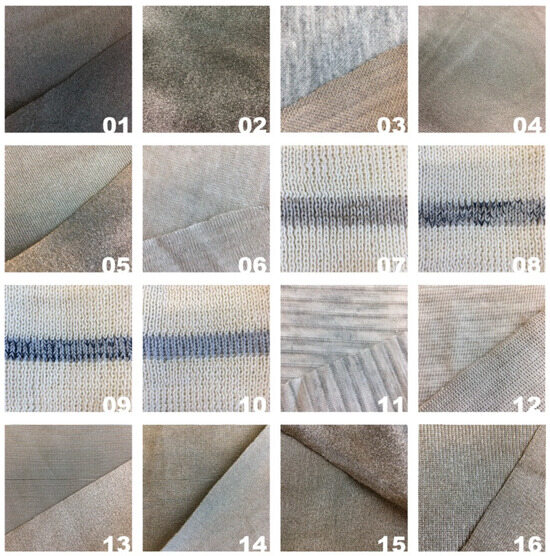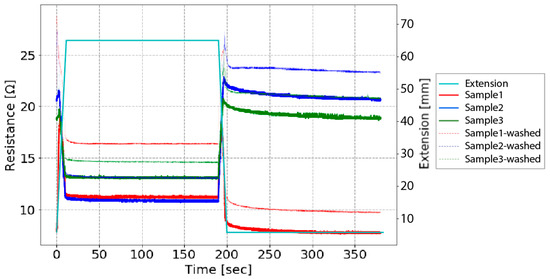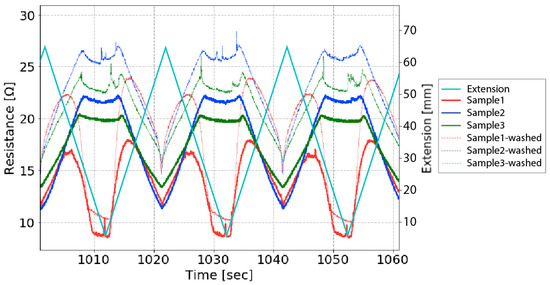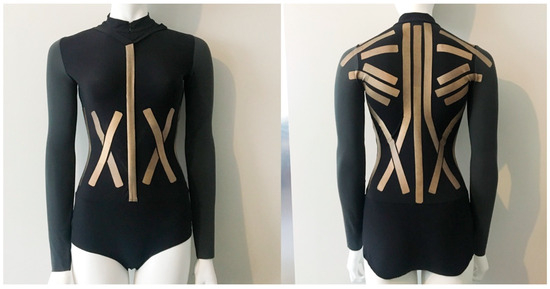Abstract
This paper presents research about design a textile-based stretch sensor for making a reliable sensing system for dance movement sensing. We examined sixteen textile-based conductive stretch sensors that were made with commercially produced conductive materials. Through the analysis of their sensitivity, linearity, hysteresis, responsiveness, and fatigue, a silver-plated conductive fabric, Technik-tex P130B, shows the best performance for dance movement sensing. Then, we tested the bonding technique, and washability of Technik-tex P130B-made sensors. The finding shows that bonding makes a noticeable impact on sensor performance. Both bonding and washing increase the sensor’s resistance. Technik-tex P130B on one side bonding has the best performance for dance movement sensing. This reliable and washable textile-based stretch sensor is utilised for dance bodysuit making for further development.
1. Introduction
In the past decades, computer technology has been extensively used in the performing arts [1].
It strengthens and extended the form of expression of arts as it includes text, graphics, audio, video, etc. As technology develops, to enhance the appearance of art, technology has been added into the performing arts to create interactive effects [2]. Interactive multimedia built another level of performing arts, as it not only gives the multiple sense of the art, but also includes interaction with the audience or performer.
In the dance performance, the motion-sensing technology [3] is essential as the body language is the crucial point of dance to express the performer’s expression. In this case, the motion-sensing interactive performance becomes the new form of dance performing to enhance the performance on stage. To strengthen the interaction of the dancing performance brings the need for motion sensing. The camera was the original idea for the motion capture as it can record and recognise body movement visually by computer vision. However, external equipment is always complicated to set up and cannot capture the detail or small scale of action, especially by only a few cameras. Then, wearable technology [4] becomes the progressive idea which directly captures data from the body. To obtain the data from the body by carrying the sensors, it can capture the movement precisely by placing more sensors on a different location on the body.
More recently, with an increasing range of applications for wearable devices, research into electronic textiles has attracted considerable attention [5]. E-textiles have been used mainly on the garment for sensing body information, as it can be incorporated into everyday clothes. Stretch is an initial property of the fabric. It was used widely for clothing such as sportswear, performance wear, and casual outfits. It makes clothes comfortable and more fitted on the body because of its elastic property. The property of stretch perfectly fits the needs of the sensor for body movement. The textile stretch sensor is the ideal option for dancing body motion sensing. It can be tightly fitted to the body so that it precisely captures the data just next to the skin from wearers.
Our research is interested in using textile-based stretch sensors for dance movement sensing. Before we make a sensing system for dance application, sensor’s properties, reliability, and washability need to be evaluated and examined. The aesthetics and comfort of the sensors are considered alongside their sensing properties.
2. Materials and Methods
To design and make a reliable stretch sensor that can integrate into a dance bodysuit for dance movement sensing, we compared the properties of different conductive materials [6] and tested the bonding technique and sensor’s washability [7].
2.1. Evaluation of Textile Conductive Stretch Sensors
We chose fourteen commercially produced conductive materials (Figure 1) to make sixteen stretch sensors. There are twelve conductive stretchy fabrics and two kinds of conductive threads. All the conductive fabrics were cut into 20 mm × 100 mm pieces. The conductive threads were knit in our lab using a gauge 7 Dubied knitting machine with six rows in height, 30 needles on a double bed with a stitch tension of 9.5.

Figure 1.
Photographs of the sixteen sensors along with their sensor number.
We analysed and compared the result of each sensor’s sensitivity, linearity, hysteresis, responsiveness, and fatigue in both dynamic and static tests.
- Dynamic test: The samples were stretched and released 100 times between 10% and 70% strain at a speed of 6 mm/s.
- Static test: The samples were initially stretched at a speed of 6 mm/s, then stopped and held for three minutes at 70% strain. Then, the samples were released at 6 mm/s and held for three minutes at 10% strain.
2.2. Bonding and Washing Test
Bonding is a technique that is often used to attach two pieces of fabric. Theoretically, bonding will stabilise and protects the conductive materials so the sensor can be more stably placed on the dance leotards to fit the body, so the sensing system can sense body movement more accurately.
We tested the effects of bonding and washing on the sensor’s performance. Three sensors made with Technik-tex P130B have been tested in this study: (i) conductive fabric only, (ii) conductive fabric bonded on one side to Eurojersey fabric, and (iii) conductive fabric with Eurojersey bonded on the top and bottom of the conductive fabric. The three samples were washed three times using a standard textile washing and drying method (ISO 6330:2000). The samples were put in a protective textile bag using a front-loading washing machine with 40 C and 800 spins and then flat dried in the open air. Each sensor was tested under static test and dynamic test before and after washing.
3. Results and Discussion
We analysed the sensitivity, linearity, hysteresis, responsiveness, and fatigue of textile knit stretch sensors as described in [6]. Among the sixteen textile stretch sensors, a silver-plated sensor using conductive fabric material Technik-tex P130B met the sensor requirement for dance movement sensing the best. It has a relatively small working range, which will be more sensitive for small-scale movement sensing.
Figure 2 and Figure 3 show the three samples of the Technik-tex P130B sensor’s performance in static test and dynamic test after bonding and washing. The result shows that bonding increases the sensor’s resistance and stabilises the sensor’s performance. These three sensors are washable, but their electrical resistance will be increased by washing. There are no significant differences between one-side bonding and two-side bonding in the sensor’s performance. Still, the one-side bonding sensor was more comfortable to be worn, so that it would be more suitable for dancing bodysuit making.

Figure 2.
The three sensors’ performance of the static test before and after washing.

Figure 3.
The three sensors’ performance of the dynamic test (3 consecutive random cycles selected from the 100 cycles) before and after washing.
4. Conclusions
This paper presents a design of a textile-based stretch sensor that can be used for dance movement sensing. Sixteen sensors using commercially produced conductive materials were examined. An outstanding conductive fabric, Technik-tex P130B, was used to make a stretch sensor for bonding and washing test.
The finding shows that Technik-tex P130B has the best performance in linearity, responsiveness, and fatigue. Bonding stabilises the conductive fabric but restricts the sensor’s working range. Washing increases the sensor’s electrical resistance.
We made the prototype of a dance leotard, which placed textile stretch sensors on the centre of the body (Figure 4). The sensors use Technik-tex P130B as a conductive material, one-side bonded on the leotard. Further work will capture the movement of the back using this sensing system and compare with the Vicon motion capture system.

Figure 4.
The sensing system prototype of dance leotard.
Funding
This work was supported by the EPSRC (Engineering and Physical Sciences Research Council) and AHRC(Arts and Humanities Research Council) Centre for Doctoral Training in Media and Arts Technology (EP/L01632X/1) and the China Scholarship Council.
References
- Dixon, S. Digital Performance: A History of New Media in Theater, Dance, Performance Art, and Installation; MIT Press: Cambridge, MA, USA, 2007. [Google Scholar]
- Kassing, G. History of Dance: An Interactive Arts Approach; Human Kinetics: Champaign, IL, USA, 2007. [Google Scholar]
- Birringer, J. Dance and media technologies. PAJ J. Perform. Art 2002, 24, 84–93. [Google Scholar] [CrossRef]
- Tehrani, K.; Michael, A. Wearable technology and wearable devices: Everything you need to know. Wearable Devices Magazine, 26 March 2014. [Google Scholar]
- Tomico, O.; Wilde, D. Soft, embodied, situated & connected: Enriching interactions with soft wearables. mUX J. Mob. User Exp. 2016, 5, 3. [Google Scholar]
- Liang, A.; Stewart, R.; Bryan-Kinns, N. Analysis of sensitivity, linearity, hysteresis, responsiveness, and fatigue of textile knit stretch sensors. Sensors 2019, 19, 3618. [Google Scholar] [CrossRef] [PubMed]
- Liang, A.; Stewart, R.; Freire, R.; Bryan-Kinns, N. Effect of bonding and washing on electronic textile stretch sensor properties. In Proceedings of the 2019 ACM International Joint Conference on Pervasive and Ubiquitous Computing and Proceedings of the 2019 ACM International Symposium on Wearable Computers, London, UK, 9–13 September 2019; ACM: New York, NY, USA, 2019; pp. 121–124. [Google Scholar]
Publisher’s Note: MDPI stays neutral with regard to jurisdictional claims in published maps and institutional affiliations. |
© 2019 by the authors. Licensee MDPI, Basel, Switzerland. This article is an open access article distributed under the terms and conditions of the Creative Commons Attribution (CC BY) license (https://creativecommons.org/licenses/by/4.0/).